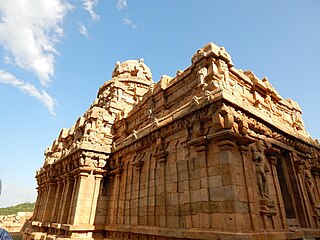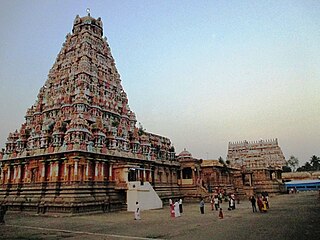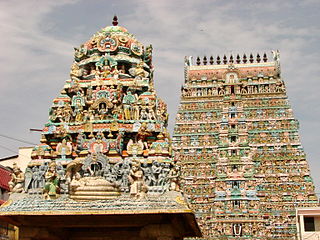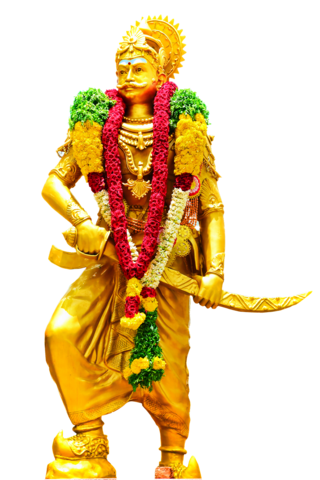
Tamil Jains are ethnic-Tamils from the Indian state of Tamil Nadu, who practice Jainism, chiefly the Digambara school. The Tamil Jain is a microcommunity of around 85,000, including both Tamil Jains and north Indian Jains settled in Tamil Nadu. They are predominantly scattered in northern Tamil Nadu, largely in the districts of Tiruvannamalai, Kanchipuram, Vellore, Villupuram, Ranipet and Kallakurichi. Early Tamil-Brahmi inscriptions in Tamil Nadu date to the third century BCE and describe the livelihoods of Tamil Jains. Samaṇar wrote much Tamil literature, including the important Sangam literature, such as the Nālaṭiyār, the Cilappatikaram, the Valayapathi and the Civaka Cintamani. Three of the five great epics of Tamil literature are attributed to Jains.

The Pandyan dynasty, also referred to as the Pandyas of Madurai, was an ancient Tamil dynasty of South India, and among the four great kingdoms of Tamilakam, the other three being the Pallavas, the Cholas and the Cheras. Existing since at least the 4th to 3rd centuries BCE, the dynasty passed through two periods of imperial dominance, the 6th to 10th centuries CE, and under the 'Later Pandyas'. Under Jatavarman Sundara Pandyan I and Maravarman Kulasekara Pandyan I, the Pandyas ruled extensive territories including regions of present-day South India and northern Sri Lanka through vassal states subject to Madurai.

The Pallava dynasty existed from 275 CE to 897 CE, ruling a significant portion of the Deccan, also known as Tondaimandalam. The Pallavas played a crucial role in shaping in particular southern Indian history and heritage. The dynasty rose to prominence after the downfall of the Satavahana Empire, whom they had formerly served as feudatories.

Simhavishnu also known as Avanisimha son of Simhavarman III and one of the Pallava kings of India, was responsible for the revival of the Pallavan dynasty. He was the first Pallava monarch whose domain extended beyond Kanchipuram (Kanchi) in the South. He was portrayed as a great conqueror in Mattavilasa Prahasana, a drama written by his son Mahendravarman I.

The Chola dynasty was a Tamil dynasty originating from southern India. At its height, it ruled over an expansive maritime empire known as the Chola empire. The earliest datable references to the Chola are from inscriptions dated to the 3rd century BCE during the reign of Ashoka of the Maurya empire. The Chola empire was at its peak and achieved imperialism under the Medieval Cholas in the mid-9th century CE. As one of the Three Crowned Kings of Tamilakam, along with the Chera and Pandya, the dynasty continued to govern over varying territories until the 13th century CE.

Vijayalaya Chola was a descendant of the Early Cholas, who revived the Chola dynasty and founded the Imperial Chola Empire. He ruled over the region to the north of the river Kaveri. He is one of the descendants of the famous Sangam age Chola king, Karikala Chola. According to the Anbil plates of Parantaka Chola II, his predecessor is Srikantha Choladhiraja, a Telugu Chola king who ruled the Renadu region and belongs to the Pottapi Chola lineage and is a descendant of the ancient Tamil king, Karikala Chola. Vijayalaya was succeeded by his son Aditya Chola I who laid the foundation of the Imperial Chola Empire.

The Kalabhra dynasty, also called Kaḷabrar, Kaḷappirar, Kallupura or Kalvar, were rulers of all or parts of Tamil region sometime between the 3rd century and 6th century CE, after the ancient dynasties of the early Cholas, the early Pandyas and Chera. Information about the origin and reign of the Kalabhras is uncertain and scarce. It is believed by historians that the Kalabhras belonged to the Vellalar community of warriors who were possibly once the feudatories of the Cholas and the Pallavas. Their proposed roots vary from southeast region of modern Karnataka, Kalappalars of Vellalar community, to Kalavar chieftains. This age is generally called "The Augustan age of Tamil Literature", in a 1922 book by the name "Studies in South Indian Jainism" written by M. S. Ramaswami Ayyangar and B. Seshagiri Rao. The Kalabhra era is sometimes referred to as the "dark period" of Tamil history, and information about it is generally inferred from any mentions in the literature and inscriptions that are dated many centuries after their era ended.

The Telugu Chodas or Telugu Cholas ruled parts of present-day Andhra Pradesh and Telangana between the 5th and the 13th centuries as samantas of Pallavas and later the Imperial Cholas. Various dynasties exist among them including Velanati, Pottapi, Konidena, Nannuru, Nellore, Kunduru etc. The earliest Choda dynasty in the Telugu area was that of Renati Chodas who ruled Renadu region from late 5th century to 7th century. Some of the Telugu Chodas including Renati Chodas claimed descent from the early Sangam Tamil king Karikala Chola.Telugu Chodas contributed much to the early development of Telugu language and are the first dynasty to use Telugu as their official language. The first and oldest Telugu inscription founded so far is Kalamalla inscription dating to 575 CE put up by Renati Chola king Erikal Mutturaju Dhanunjaya. Telugu Chodas are believed to have been migrated from Tamilakam to Andhra country due to invasion of Tamilakam by Kalabhras and increasing power of Pallavas in northern most part of Tamilakam.

The region of Tamil Nadu in the southeast of modern India, shows evidence of having had continuous human habitation from 15,000 BCE to 10,000 BCE. Throughout its history, spanning the early Upper Paleolithic age to modern times, this region has coexisted with various external cultures.

Narthamalai, a cluster of small hills, is 25 km from Trichy on the Trichy-Pudukottai highway in the state of Tamil Nadu, India. Here can be seen some of the oldest rock cut cave temples, as well as the longest rock-cut edicts, similar to Asokan edicts and extremely rare in the south of India. The town houses Vijayalaya Choleeswaram built during the 9th century. The two rock-cut temples are classic examples of how temple architecture styles were fusing in different parts of the country.

Pazhayarai or Pazhaiyarai or Palayarai was an ancient capital of the medieval Chola dynasty in Tamil Nadu. The place is located around 7 km (4.3 mi) from Kumbakonam, a city in Thanjavur district, in the South Indian state of Tamil Nadu. It is located on the banks of T.Patnam river, one of the distributaries of the river Kaveri. There are a number of villages within the area of historic Pazhaiyarai. The place was called Ayiratalli, meaning a land of thousand temples. The place is referred under various names like Ayiratalli, Pazhayar, Ahavamallakulakalapuram and Minavanaivenkadasolapuram.

The Kampaheswarar Temple or kampa-hara-ishvarar is a Hindu temple dedicated to the god Shiva. It is situated in Thirubuvanam, a village in Thanjavur district in the South Indian State of Tamil Nadu, on the Mayiladuthurai-Kumbakonam road. Shiva is worshiped as "Kampahareswarar" as he removed the quaking of a king who was being haunted by a Brahmarakshasa. It was built by Kulothunga Chola III and is considered the last of the four masterpieces built during the Medieval Chola era.

Jainism has an extensive history in the Indian state of Tamil Nadu, although practiced by a minority of Tamils in contemporary times. According to the 2011 India Census, Jains represent 0.12% of the total population of Tamil Nadu, and are of the Digambara sect. Tamil Jains are primarily concentrated in northern Tamil Nadu, in the districts of Madurai, Viluppuram, Kanchipuram, Vellore, Tiruvannamalai, Cuddalore and Thanjavur.

Tamil Nadu is known for its ancient temple architecture. Nearly 33,000 ancient temples, many at least 800 to 2000 years old, are found scattered all over Tamil Nadu. As per Tamil Nadu Hindu Endowments Board, there are 38,615 temples. Most of the largest Hindu Temples reside here. Studded with complex architecture, a variety of sculptures, and rich inscriptions, the temples remain the very essence of the culture and heritage of Tamil land, with historical records dating back to at least 3,000 years.

Vijayalaya Choleeswaram in Narthamalai, a panchayat town in Pudukottai district in the South Indian state of Tamil Nadu, India, is a temple dedicated to the Hindu god Shiva, Vishnu and houses the 8th century Jaina Abode. The temple is considered one of the oldest stone temples in South India. The other portions of Narthamalai houses the 8th century Jaina Abode, the Aluruttimalai Jain Caves. The Temple is Constructed in the Dravida style and rock cut architecture, the temple is believed to have been built during the 9th century by Mutharaiyar dynasty kings, the cardinals of Pallavas, with later expansion from the Cholas. The rock-cut architecture is an early example of Cholan Art, continuing the tradition of the Pallavas.

Kunnandarkoil Cave Temple in Kunnandarkoil, a village in Pudukottai district in the South Indian state of Tamil Nadu, is dedicated to the Hindu god Shiva. Constructed in Rock-cut architecture, the temple is believed to have been built during the 8th century by Muttaraiyar kings, the cardinals of Pallavas, with later expansion from the Vijayanagar Empire. The rock-cut architecture in the temple is a specimen of the late Pallava Art and an early example of Chola Art. The temple has various inscriptions from Cholas, Chalukyas, Pandyas and Vijayanagar Empire. The temple is considered one of the oldest stone temples in South India. The temple is maintained and administered by Department of Archaeological Survey of India as a protected monument.

Perumbidugu Mutharaiyar, also known as Suvaran Maran and Perarasar Perumbidugu Mutharaiyar, was a king of Thanjavur from the Mutharaiyar dynasty. He ruled over Thanjavur, Trichy, Pudukkottai, Perambalur and Thiruvarur as a feudatory of the Pallava dynasty. He attended the coronation of Nandivarman II.

Trilokyanatha Temple, also called Thirupparuthikundram Jain temple or Jeenaswamy Trilokyanathar temple, is an 8th-century Digambara Jain temple in Thiruparthikundram, in northeast Kanchipuram in Tamil Nadu, India. The suburb and the area around this temple is also called Jain Kanchi. The stone temple is dedicated to the Jain Tirthankaras, but is notable for integrating Hindu deities with Jain deities within the premises of the temple, particularly as Ksetrapalas. Constructed in Dravidian architecture, the temple was built during the reign of Narasimhavarman II of the Pallava dynasty. The temple was expanded by the Jain community with financial support of Medieval Cholas, later Pallavas and Vijayanagar kings.

Tamil dynasties are the kingdoms who ruled over present day Tamil Nadu, Sri Lanka, Andhra Pradesh, Karnataka, Kerala and Odisha. These include the Pallavas, the Pandyas, the Cholas and the Cheras.
Srikantha Chola was a Telugu Chola ruler belonging to Pottapi Chola family which claims descent from ancient Tamil king Karikala Chola. He was ruling Renadu region as a feudatory of Pallavas. Srikantha was succeeded by Vijayalaya Chola.

















